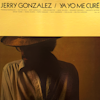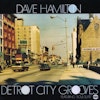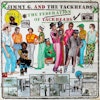Trumpeter and conguero Jerry González was a brilliant but polarizing character. His musical genius and infectious personality made him a crucial element in the Nuyorican musical explosion of the 1970s. González’s deep dedication to jazz and Afro-Caribbean music made him a unique player at the same time, one that demanded attention, even though the attention he gained was often as bad as it was good. He was a lightning rod that would help launch Kip Hanrahan’s American Clavé label with possibly the most legit melding of jazz and Afro-Caribbean music ever on Ya Yo Me Curé.
González was born in 1949 in New York City and grew up with younger brother, bassist Andy, in the Edenwald Houses projects in the Eastchester section of the Bronx. Their father, Geraldo Gonzalez, was a vocalist and music enthusiast, who introduced his sons to popular Latin sounds of the period along with the Latin jazz sounds of Cal Tjader and Dizzy Gillespie. Jerry began playing trumpet in junior high. In eighth grade, Jerry broke his leg in a fall from a rope swing, making it necessary for him to stay home to recover. With time on his hands, he began to learn to play congas along with records by Mongo Santamaria and Tito Rodriguez.
While González attended the High School of Music and Art in Manhattan, his parents moved to a house at 1963 Gildersleeve Avenue in the South Bronx. Their basement would soon become one of the most important incubators of progressive Latin music.
After attending New York College of Music, Jerry jumped straight into the world of a professional musician. He had developed an approach to congas where he would play five drums, all tuned differently, allowing for a more melodic approach. Jerry was quickly scooped up by Dizzy Gillespie, who added Andy a short while later when the bassist was only nineteen years old. Attention from the real deal salseros and Latin legends was quick to follow, Jerry falling in with the likes of Tito Puente and Eddie Palmieri.
The brothers were looking to do something on their own come the mid-’70s. They started a short lived descarga group that they called Conjunto Anabacoa, after a Juanchín Ramírez tune made famous by Beny Moré. Jams in their parents’ basement led to regular affiliation with timbalero Manny Oquendo, which led to the birth of Libre, the outstanding salsa outfit. The jams continued to evolve. The basement could uncomfortably fit fifteen musicians and housed a hi-fi and a piano. As the brothers continued to delve into Cuban music, they began to hang at authority and producer René López’s house, eventually inviting him to their jam sessions.
These jams would become day long explorations of the folkloric and popular music from Cuba and Puerto Rico. A number of brilliant musicians with Cuban and Puerto Rican roots began to take part, including trumpeter Alfredo “Chocolate” Armenteros, tresero Nelson Gonzalez, and percussionists Milton Cardona, Frankie Rodriguez, and Gene Golden. An ever-ready hustler, Jerry procured a gig opposite former employer McCoy Tyner’s band at Wesleyan College and in response formed Grupo Folklorico y Experimental Nuevayorquino. Two groundbreaking recordings on Salsoul (produced by René López) helped solidify the group’s work in Nuyorican music history and led to the signing of Libre.
Kip Hanrahan was also raised in the Bronx. Though he was of Irish-Jewish extraction, Hanrahan grew up within the strongly Puerto Rican community, even becoming an amateur percussionist himself. He met the González brothers in the local music scene, glomming onto the dynamism of Jerry immediately. While attending Cooper Union to study art, Hanrahan became involved with composers Carla Bley and Mike Mantler’s Jazz Composer’s Orchestra Association Inc. label and their New Music Distribution, where he worked on and off during the 1970s. It was through these connections that Hanrahan befriended legendary jazz producer Teo Macero, who brought Hanrahan to observe and learn in the studio.
Hanrahan’s American Clavé label began by accident. Hanrahan had planned to make a film with poet and author Ishmael Reed, a project that fell apart. While he was figuring out what to do next, Hanrahan was involved in an accident with a city cab, which resulted in a settlement. What should he do with the money? Produce an album, of course. Hanrahan called his friend Andy González to see if he had any thoughts of what he should do, to which Andy replied that Jerry would be “tickled to record” an album as a leader.
With that, Hanrahan booked Bley and Mantler’s Grog Kill Studios in Willow, New York, for three days at the end of July and beginning of August 1979. Hanrahan chose a unique challenge for his first efforts at producing a record. After setting up hotels and travel arrangements for eight musicians, González brought fourteen guys with him. He also missed the first day of recording.
But González did recognize the importance of the moment. He and his coterie of musicians were sick of the cuchifrito scene and wanted to share their singular developments that merged the Afro-Caribbean culture of New York and the defiant sounds of African American jazz. From there, Jerry put his whole heart into the proceedings.
Vocalist/percussionist Frankie Rodgriguez provided three tunes for the recording, including the lead-off track, “Agüeybana Zemi,” a tune named after a powerful chief of Puerto Rico’s native Taíno people who was the first to receive conquistador Ponce de León. An aggressive percussive montuno is a perfect backdrop for Hilton Ruiz’s scorching piano solo. An introspective take on Wayne Shorter’s ballad “Nefertiti” is dedicated to Jerry’s hero, Miles Davis, whose influence is audible in González’s cool trumpet tone. The title track “Ya Yo Me Curé” (meaning “I’ve already healed myself”) is led by composer Rodriguez’s bright vocal and the rest of the ensemble as coro. “The Lucy Theme,” which ends the A-side, might seem like a cheeky choice for the album, but the I Love Lucy Show was the first mainstream outlet to feature an explicitly Latino person on television, and the combo, whittled down to a trio, treats the theme with playful appreciation through Jerry’s insistent congas, Andy’s pliant bass, and Ruiz’s brilliant piano.
The group’s off-kilter interpretation of Thelonious Monk’s “Evidence” features drum great Don Alias on kit adding to the rhythmic swarm of percussionists (who included Carlos Mestre, Gene Golden, Vincente George, and Nicky Marrero along with Edgardo Miranda on quatro), while González’s lithe trumpet soars over all. Credited once again to Rodriguez, “Baba Fieden Orisha” is the most authentically folkloric tune, with an infectious, straight-up Afro-Cuban rumba rhythm. The recording concludes with the group spicing up the de facto Latin jazz standard, “Caravan.” The piece adds the slamming horn section of Dominican sax giant Mario Rivera and trombonists Steve Turre and Papo Vasquez.
Ya Yo Me Curé was born of a tumultuous relationship between Hanrahan and Jerry González. The producer would recruit González on future projects, but the two would eventually end up on the outs. Most importantly, Ya Yo Me Curé was the seed of what would become Jerry and Andy’s most well-known ensemble, the Fort Apache Band, which was named in protest to the media’s racist take on the Bronx and its Puerto Rican residents, exemplified by the film, Fort Apache, the Bronx.
Kip Hanrahan admits that his label name was a bit of a joke, for what is an American Clavé but a “strict 4/4.” But there might not be a more appropriate descriptor for Jerry González’s debut recording, as it stands as the most distinctive fusion of musical elements from America’s most musically influential diasporic cultures, African American jazz, Latin American folkloric music, and Afro-Caribbean rhythms.
RIP, Jerry and Andy González.


